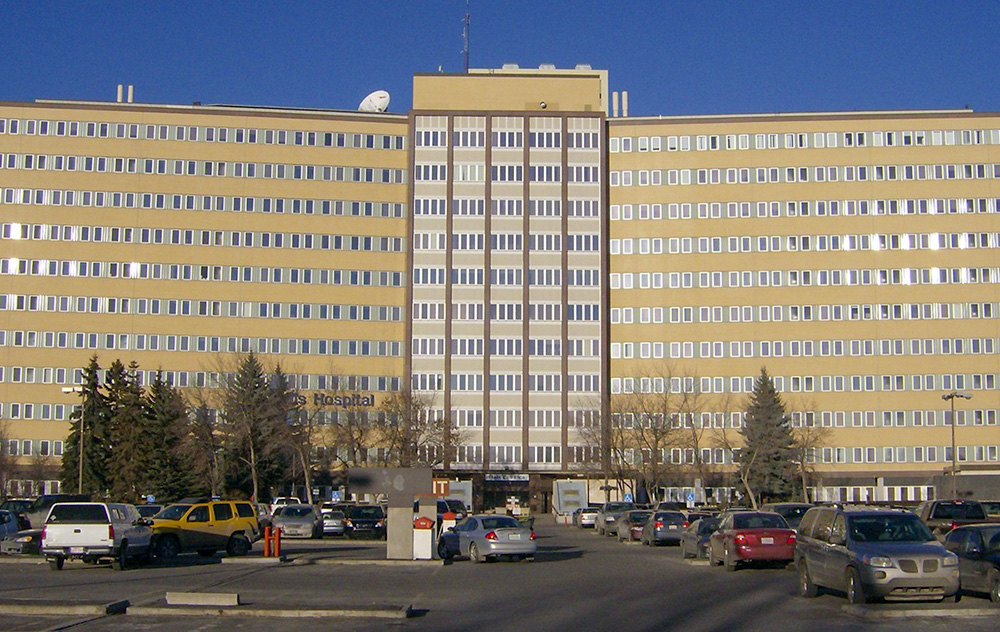U of A studies using common goldfish could provide insight into the long-term effects of chemical pollutants in our water sources.
[Editor's Note: Article was accurate at time of original publication in the Spring 2007 issue of New Trail.]
As you can see from his photo, Biological Sciences professor Miodrag (Mike) Belosevic has a vested interest in keeping Alberta's water pure. He's an avid (some say rabid) fly-fisherman and part of his decision to make his home here was the fish
When Belosevic, who's originally from Montenegro, wanted to emigrate to Canada 36 years ago, he first chose Montreal because he spoke French. He didn't arrive in Alberta until 1988 after getting two degrees from the University of Manitoba, a PhD from McGill, and doing post-doctoral work in Washington, D.C.
"Three things brought me here," he says. "One: this is an outstanding university and many people do not realize how good the U of A is in terms of the kinds of students we graduate, and also the support network available at the University is phenomenal. I've been very, very happy here. Two: my wife is a prairie girl originally from Manitoba and she wanted to come back to this region, back to the prairies. Three: some of the best trout fishing streams in the world are in Alberta - that was absolutely part of the process in making the decision to come to the U of A."
But the catch of the day in Belosevic's nine-to-five existence is a less exotic species of water-living, cold-blooded animal - Carassius auratus, more commonly known as a goldfish. He is using the common ornamental carp to try to better understand exactly what chemical pollutants are in our water bodies and what long-term effects these chemical pollutants have on the physiological systems of humans and animals.
"There's a paucity of studies that have looked at long-term, chronic exposure to low levels of these chemicals," he says. "We really don't know at the present time what the long-term effect of these kind of exposures will be in terms of human health. Do these chemical pollutants accumulate in our bodies and if they do so will they, down the road, cause specific effects?
"Also, there are many chemicals that are similar in nature that are found in water bodies. Each chemical occurs at very low levels individually, but nobody knows whether together or synergistically they could induce the same biological effect."
The chemicals he's talking about run the gamut from pharmaceuticals consumed by human beings - such as anti-seizure medications, anti-inflammatory drugs, and endocrine disruptive substances such as birth control pills - to poly-aromatic hydrocarbons, which are commonly found in petroleum fuels, coal products and tar, and have been known to cause cancer at high concentrations. There are also the chemical fertilizers spread on the land, and the growth hormones and other substances ingested by agricultural animals.
"Do these chemical pollutants accumulate in our bodies and if they do so will they, down the road, cause specific effects?"
"A lot of this stuff has been around for a long time," says Belosevic. "And all of it ends up in the environment after either being excreted by humans or animals or simply spilled on the land. Traces of these substances and some of these materials are present in water."
To try to find out what the long-term effects of having these various substances in our bodies is where the goldfish come in.
"The latest study was funded by the Alberta Ingenuity Centre for Water Research," Belosevic says. "We used goldfish because they're a very hardy fish that survive over a range of temperatures. What we did is we exposed the fish to water that hadn't been treated to remove all the traces of the chemicals I mentioned. Using this fish model system we were asking the questions as to whether or not the gene expression of the goldfish changes, if molecular changes occur, if there are any physiological processes that are changing in these fish over time? We're using the goldfish like the canary in the coal mine.
"We're now writing the papers for publication showing that some of these chemicals, even though they occur at very, very low concentrations, do affect the physiological status of fish. To what extent these physiological parameters can be transferred to human beings is debatable, but nevertheless we do know that there are biological effects that these chemicals will induce in our fish species.
"Obviously a lot more research needs to be done in this area. But we know that a variety of chemicals are present in our water - including pesticides, household cleaning products, battery acids, pharmaceuticals, and ant poison. All of these chemicals occur in such low quantities that Alberta Environment suggested in a recent report that they may not pose a significant threat to human health. However, a group of compounds that cause similar biological effects, such as anti-inflammatory drugs - that we know are present in reusable water - may exceed the compound guideline levels and, in fact, cause biological effects."
The next step for Belosevic is to recreate the entire experiment in a more controlled laboratory environment - the previous experiment was done in a water treatment plant with the goldfish kept in large plastic tanks. Using the same chemical compounds found in the so-called reusable water in the wastewater treatment plant, he's going to tweak the amounts present in the water to see whether increases or decreases in any one of these chemicals cause further physiological effects.
"This is all done on a long-term, chronic basis," he says. "One experiment is usually about half a year long. It takes a long time to do these kind of studies."
So we know these nasty substances are in our water and we're starting to understand that perhaps it's not a good idea that we continue to ingest them - although the jury's still out on what the effects of long-term exposure to very minute traces of these elements are to human physiology. Can we get them out of the water supply? The answer is, yes, we can get most of that stuff out, or certainly reduce the concentration levels to the point where they're negligible. But, of course, that comes at a cost.
"Here we pay minimal amounts for water compared to some places, such as Europe," says Belosevic. "We haven't developed a culture of water conservation the way they have in Europe. You'd be hard pressed to go a European hotel and not find a water-conserving showerhead or a low-flow toilet."
Belosevic did some work in Holland where he demonstrated that the use of advanced oxidation methodology, using ozone/hydrogen peroxide, was effective in reducing pesticides in drinking water by as much as 98 percent. Ultraviolet radiation can also be employed in Canada to destroy some of these chemicals that are found in the water. Both of these systems can also be used to kill waterborne parasites. They work by damaging or penetrating the tough outer shells, the cyst walls, of the parasites and damaging the DNA, thereby preventing the reproduction of the parasites
Belosevic was also instrumental in developing an inexpensive, laser-based technique for assessing the presence of protozoan parasites in drinking water, and a technique that uses nucleic acid stains, or tests, to determine whether or not the water treatment process has been successful in removing all of the potentially harmful pathogens.
He could have patented these techniques and possibly made a lot of money, but it would have taken much longer to get them to market if he had. "I didn't patent this because I believe that these tests are of such incredible urgency for the protection of public health," says Belosevic. "I wanted these assays on the market as soon as possible. And I am happy to announce that, in fact, many water utilities in North America and around the world are using them as we speak to protect people from waterborne protozoan infections."
Another technique for removing chemicals from water is a high-level filtration system, filtration on the nano-technology level. This technique can effectively filter out a majority of the chemicals, but not all of them. But, once again, if you put all these systems in place you're dealing with added cost to the overall treatment process.
"For much of Holland," Belosevic says, "the drinking water comes from the Rhine River and, as you know, the Rhine goes through most of Europe and there's lots of industrial and agricultural stuff in there, such as pesticides, and as a consequence they had to deal with the chemical issue. And so they did. In most of Europe they either use filtration or the method we developed in Holland. Either method works reasonably well, but it does add cost to making clean drinking water and, of course, everything gets passed on to the consumer eventually.
"Most of the wastewater treatment plants that I'm aware of in North America are not designed at the present time to remove some of these chemicals from wastewater as well as drinking water," says Belosevic. "Both the American Environmental Protection Agency and Canadian water treatment regulators do not require removal of these chemicals at the present time simply because the concentrations in water bodies are below national guidelines. But I think it would be prudent to do enough of a research data set to show whether or not the effects of these chemicals are a serious threat to human health."
And if someone is going to generate such a data set, it's probably going to be Belosevic and his team of graduate and undergraduate students who are always keen to work with the winner of the 2006 U of A University Cup - awarded for excellence in teaching, research and community service - the 2004 Killam Award for excellence in mentoring, the ASTech Foundation award for outstanding achievement in applied technology and innovation (2003), the Wardle Medal for outstanding contributions to parasitology in Canada (2002), and the U of A Killam Annual Professorship (2001).
"I think it would be prudent to do enough of a research data set to show whether or not the effects of these chemicals are a serious threat to human health."
While presenting him with the prestigious University Cup, U of A president Indira Samarasekera said, "Dr. Belosevic embodies the best of teaching and research at the University of Alberta. He cares deeply about both his work and his students, and it shows in the level of excellence he has achieved in his many years as part of our University."
In fact, if you're ever in his office you'll notice one wall is festooned with photos of the smiling graduate students (including a Maori prince) who have come under Belosevic's tutelage during his 20 years of teaching at the U of A, all of whom - except one whom he lost track of when he went to Harvard - he has kept tabs on. "I'm proud to say that 98 percent of my graduate students have positions in the biology or environmental engineering fields," he says.
And while you're in his office you'll also notice Belosevic's many pictures on the wall of him fishing, and on his computer under the file-heading of "MikePlay." So the final question is, if the water we're drinking is definitely affecting the physiology of goldfish living in it, does Belosevic eat the trout he catches in the province?
"No," he laughs. "I always practise catch and release. Not because I'm worried about eating them, but because sport fish such as trout have a very hard time surviving the Alberta winter. Many of the streams freeze right to the bottom, and I primarily fish the streams rather than lakes. The fish have to find places where there are natural springs in order to survive. So why would I put something like that in a frying pan?"






























































































































































































































































































































































































































































We at New Trail welcome your comments. Robust debate and criticism are encouraged, provided it is respectful. We reserve the right to reject comments, images or links that attack ethnicity, nationality, religion, gender or sexual orientation; that include offensive language, threats, spam; are fraudulent or defamatory; infringe on copyright or trademarks; and that just generally aren’t very nice. Discussion is monitored and violation of these guidelines will result in comments being disabled.